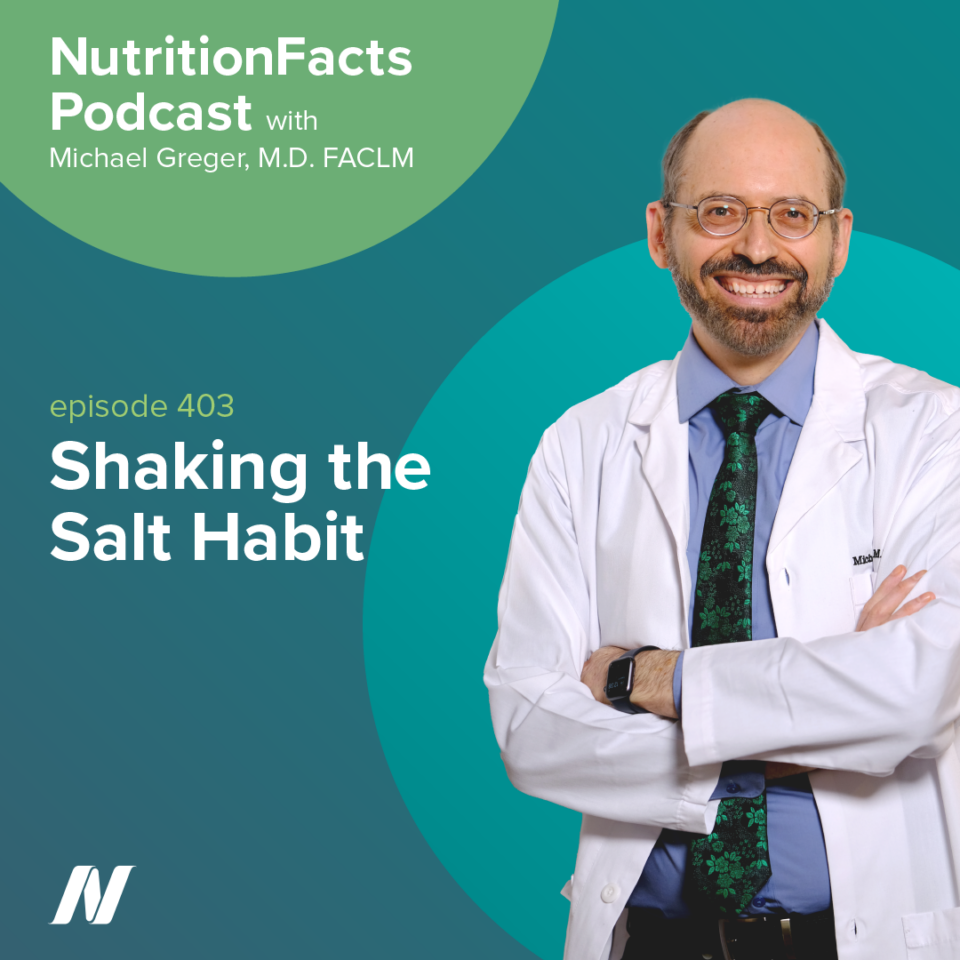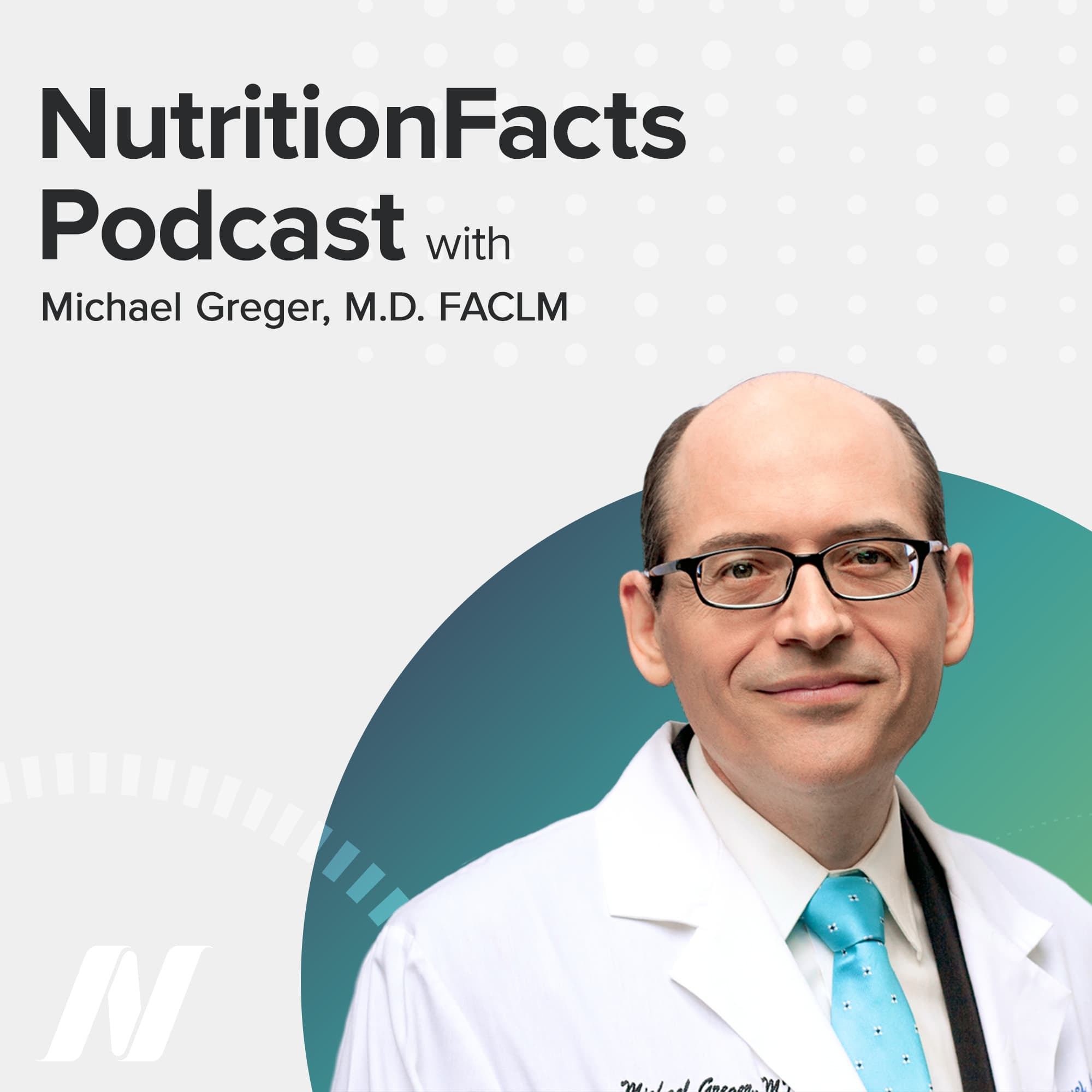We know it’s possible to cut down our salt intake. So, what are three practical steps we can take?
The two most prominent dietary risks for death and disability in the world are not eating enough fruit and eating too much salt. Too little fruit kills nearly five million people every year, and too much salt kills four million.
There are three things we can do to lower our salt intake. First, don’t add salt at the table. A third of us add salt to our food before even tasting it! Number two: stop adding salt when cooking. At first, the food will taste bland. Two to four weeks later, however, as the sensitivity of the salt taste receptors in the mouth will adjust to the taste of salt in the usual concentrations. Believe it or not, but after two weeks, you may actually prefer the taste of food with less salt. Some of the flavorings you can use instead in the meanwhile instead of salt include pepper, onion, garlic, tomato, sweet peppers, basil, parsley, thyme, celery, lime, chilli, nettle, rosemary, smoke flavor, curry, coriander, and lemon.
Even if you did add salt, though, it’s probably better than eating out, where even at non-fast food restaurants, they tend to pile it on. And finally, avoid processed foods that have salt added.
In most countries, only about half of sodium intake comes from processed foods; so, there’s more personal responsibility, but in the U.S., even if we completely stopped adding salt in the kitchen and dining room, it would only bring down salt intake a small fraction. This has led public health commentators to note how challenging it is, then, for everyone to reduce their salt intake, since so much of our sodium intake is out of our control. But is it? We don’t have to buy all those processed foods. We can choose not to turn over our family’s health to food corporations that may not have our best interests at heart.
If we do buy processed foods, there are two tricks we can use. Try to only buy foods with fewer milligrams of sodium on the label than there are grams in the serving size. So, if it’s a 100 gram serving size, it should have less than 100mg of sodium. Or, you can shoot for fewer milligrams of sodium than there are calories. For example, the sodium is 720; calories are 260. 720 is greater than 260; so, this has too much sodium.
That’s a trick I learned from one of my favorite dieticians of all time, Jeff Novick. The reason it works is because most people get around 2,200 calories a day; so, if everything you ate had more calories than sodium, you’d at least get under 2,300 milligrams of sodium the upper limit for healthy people under age 50. Of course, the healthiest foods have no labels at all. We should also try to buy as much fresh food as possible, as it is almost impossible to come up with a diet consisting of unprocessed natural foodstuffs that exceeds the strict American Heart Association guidelines for sodium reduction.
In our next story, we look at the ways in which salt may drive autoimmune diseases, such as multiple sclerosis, psoriasis, type I diabetes, Sjögren’s syndrome, asthma, and rheumatoid arthritis.
Millions suffer from asthma attacks triggered by exercise. Within five minutes of starting exercising, people can get short of breath, start coughing and wheezing, such that lung function significantly drops. But, on a high-salt diet, the attack is even worse; whereas, on a low-salt diet, there’s hardly a significant drop in function at all.
To figure out why, researchers had them all cough up sputum from their lungs, and those on the high-salt diet ended up with triple the inflammatory cells, and up to double the concentration of inflammatory mediators. But why? What does salt intake have to do with inflammation? We didn’t know, until now.
“The ‘Western diet,’ high in saturated fat and salt, has long been postulated as one potential…cause for the increasing incidence of autoimmune diseases in developed countries…” The rapidly increasing incidence of autoimmune diseases may be due to an overactivation of immune cells, called helper 17 cells. “The development of…multiple sclerosis, psoriasis, type I diabetes, …Sjögren’s syndrome, asthma, and rheumatoid arthritis” have all been “shown to involve [this] Th17-driven inflammation.” And, one trigger for the activation of those Th17 cells may be elevated levels of salt in our bloodstream. “The sodium content of processed foods and ‘fast food’…can be more than 100 times higher in comparison to similar homemade meals.”
And, sodium chloride, salt, appears to drive autoimmune disease by the induction of these disease-causing Th17 cells. Turns out there’s a salt-sensing enzyme, responsible for triggering the formation of these Th17 cells.
Organ damage caused by high-salt diets may also activate another type of inflammatory immune cell. A high-salt diet can overwork the kidneys, starving them of oxygen, triggering inflammation. The more salt they gave people, the more activation of inflammatory monocyte cells, associated with “high-salt intake induced” kidney oxygen deficiency. But, this study only lasted two weeks. What about long term?
One of the difficulties in doing sodium experiments is that it’s hard to get free-living folks to maintain a specific salt intake. You can do what are called metabolic ward studies, where you essentially lock people in a hospital ward for a few days and control their food intake. But, you can’t do that long term—unless you can lock people in a space capsule. Mars520 was a 520-day space flight simulation to see how people might do on the way to Mars and back.
What they found was that those on a “high-salt diet displayed a markedly higher number of monocytes,” which are a type of immune cell you often see increased in settings of chronic inflammation and autoimmune disorders.
This may “reveal one of the consequences of excess salt consumption in our everyday lives,” since that so-called high-salt intake may actually just be the average-salt intake. Furthermore, there was an increase in the levels of pro-inflammatory mediators, and a decrease in the level of anti-inflammatory mediators—suggesting that a high-salt diet has the “potential to bring about [an] excessive immune response,” which may damage the immune balance, and result in “either difficulties [in] getting rid of inflammation or even an increased risk of autoimmune disease.”
What if you already have an autoimmune disease? “Sodium intake is associated with increased disease activity in multiple sclerosis.” If you follow MS patients for a few years, those eating more salt had three to four times the “exacerbation rate,” three times more likely to develop new MS lesions in their brains, and on average, had eight more brain lesions, fourteen in their brain, compared to six in the low-salt group. So, the next step is to try treating patients with salt reduction and see if they get better. But, since reducing our salt intake is a healthy thing to do anyway, I don’t see why anyone should have to wait.
Did you know that salt can impair artery function within 30 minutes by suppressing a key antioxidant enzyme in our body? Here’s the story.
If you put people on a low-salt diet (meaning only getting twice as much sodium as they need), as opposed to a usual salt diet (where they’re getting five times more), you get a significant improvement in artery function. Lower salt, better arterial function, suggesting heart-protective effects beyond just blood pressure reduction.
Now, this was after dropping people’s salt intake by about a teaspoon a day for two weeks. What if you only dropped salt intake by like a half teaspoon a day? You still get a significant improvement in artery function, and it happens within just two days of reducing one’s salt intake. Or, even after a single meal.
A high-salt meal, which is to say just a typical amount of salt consumed in a commonly eaten meal, can significantly suppress artery function within 30 minutes. Now, is this in addition to the spike in blood pressure from salt, or because of the spike in blood pressure?
If you take people with normal blood pressure and give them a bowl of soup containing how much salt a regular meal might contain, their blood pressure goes up over the next three hours, compared to the same soup with no added salt. Now, this doesn’t happen to everyone; this is just the average response.
Some people are resistant to the effects of salt on their blood pressure. So, what if you repeated the artery function experiment on them? Even in people whose blood pressure is unresponsive to salt intake, they still suffer significant suppression of their artery function. So, even independent of any effects on blood pressure, salt hurts our arteries, and that harm begins within minutes of it going into our mouth, for our major arteries, and even our itty bitty blood vessels.
Using something called laser Doppler flowmetry, you can measure blood flow in tiny vessels in our skin. Now, to get the blood vessels to open up, they warmed up the skin. The reason we may turn pink when we get into a hot bath is that the blood vessels in our skin are opening up. And, that’s what happens. Big increase in blood flow with the warming; but that’s on the low-salt diet.
A high-salt diet starts out the same at the beginning, but after the same heating, there’s significantly less blood flow. The arteries just don’t seem to open up as well on a high-salt diet, unless you inject vitamin C into their skin. That seems to reverse the salt-induced suppression of blood vessel function.
So, if an antioxidant reverses the salt effect, then the way salt may be damaging our artery function is through oxidative stress—the formation of free radicals in our bloodstream. But how? Well, there’s an enzyme in our body that can detoxify a million free radicals a second, 24 hours a day, seven days a week. But compared to a low-salt diet, if we consume a normal-salt diet, we suppress the activity of this detoxifying powerhouse of an enzyme.
That may help explain why with our antioxidant enzymes crippled by the salt, all the excess free radicals may be crippling our arteries. But mop up those extra free radicals by infusing vitamin C into the bloodstream, and artery function returns to normal. Whereas, on a low-salt diet, if you drip vitamin C into people’s veins, nothing happens, because our antioxidant enzymes are already taking care of business and haven’t been shackled by the sodium of a normal-salt diet.
Whereas potassium, concentrated in fruits and vegetables, softens the cells that line our arteries, and increases the release of nitric oxide that allows our arteries to relax, sodium in our blood stiffens the cells lining our arteries within minutes, and reduces nitric oxide release. The more salt, the less nitric oxide is produced.
One salty meal, and not only does our blood pressure go up, but our arteries literally stiffen. That’s why we could figure out that too much salt was bad for us 4,000 years ago. Maybe we don’t need a double blind trial, maybe we don’t need to follow people for a decade; you may just have to feed someone a bag of potato chips, and take their pulse.

 Previous Podcast
Previous Podcast Next Podcast
Next Podcast